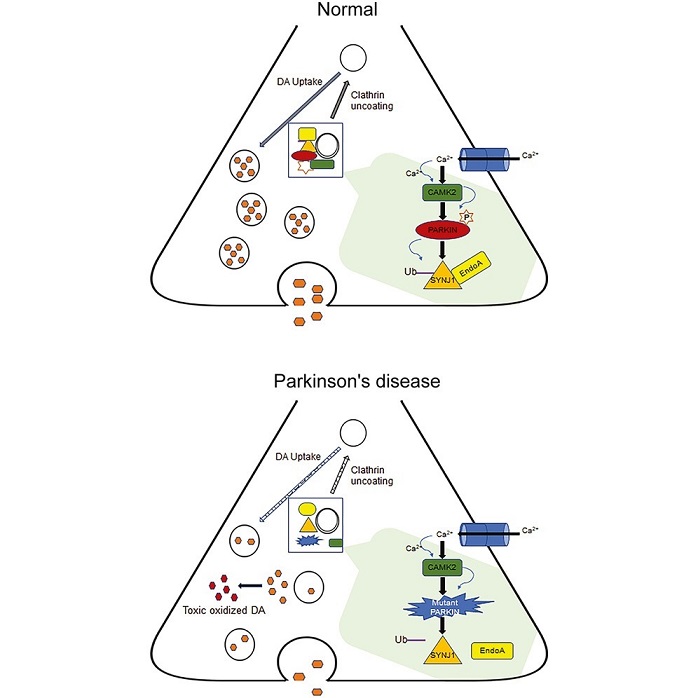Northwestern Study Shows That Parkinson's Is Caused By Dysfunctional Dopaminergic Synapses And Not By Degeneration Of Dopaminergic Neurons!
Nikhil Prasad Fact checked by:Thailand Medical News Team Sep 18, 2023 2 years, 3 months, 5 days, 6 hours, 24 minutes ago
Parkinson's disease, a debilitating neurodegenerative disorder that affects 1% to 2% of the global population, has long been associated with the degeneration of dopaminergic neurons in the midbrain. The hallmark symptoms of Parkinson's -resting tremor, rigidity, and slowness of movement are attributed to the progressive loss of these vital neurons. This classical understanding of the disease has guided research and therapeutic strategies for decades. However, a new study conducted by Northwestern Medicine - USA has disrupted these conventional beliefs, proposing that the dysfunction of dopaminergic synapses, rather than neuronal degeneration, may be the initial trigger for Parkinson's disease. This revelation offers new hope for therapeutic interventions and potentially reshapes the landscape of Parkinson's research.
 Graphical Abstract
The Traditional Parkinson's Paradigm: Neuronal Degeneration
Graphical Abstract
The Traditional Parkinson's Paradigm: Neuronal Degeneration
For years, the scientific community has largely accepted the notion that
Parkinson's disease originates from the degeneration of dopaminergic neurons. These neurons, responsible for producing dopamine - a neurotransmitter critical for motor function and mood regulation are thought to gradually deteriorate, resulting in a deficit of dopamine. This dopamine deficiency, in turn, is believed to underlie the characteristic motor symptoms of Parkinson's. The prevailing hypothesis has directed researchers toward finding ways to prevent or slow down the death of dopaminergic neurons as the primary approach to treat Parkinson's.
The Paradigm Shift: Dysfunctional Dopaminergic Synapses
This new study, led by Dr Dimitri Krainc, chair of neurology at Northwestern University Feinberg School of Medicine, has challenged this established paradigm.
The research delved into the intricate world of dopaminergic synapses - the microscopic gaps through which neurons transmit electrical signals to one another. These synapses, it was discovered, play a pivotal role in the onset of Parkinson's disease.
The groundbreaking revelation stemmed from an investigation of patient-derived midbrain neurons, a crucial step as mouse and human dopamine neurons exhibit distinct physiologies, and findings in mice are not necessarily applicable to humans. The study uncovered evidence that dopaminergic synapses were malfunctioning in various genetic forms of Parkinson's disease. This breakthrough, in conjunction with prior research by Krainc's laboratory, addresses a significant gap in the field - how various Parkin
son's-linked genes contribute to the degeneration of human dopaminergic neurons.
The Neuronal Recycling Plant Analogy
To understand the significance of the findings, imagine a neuronal recycling plant. Two workers in this hypothetical facility are responsible for recycling old or overworked mitochondria - the cellular energy producers. If these dysfunctional mitochondria are not removed, they can cause cellular dysfunction. The process of eliminating these aged mitochondria is known as mitophagy, and the key workers in this process are the genes Parkin and PINK1.
In a normal scenario, PINK1 activates Parkin, prompting the disposal or recycling of old mitochondria. It is well-established that individuals carrying mutations in both copies of either PINK1 or Parkin are susceptible to Parkinson's disease due to ineffective mitophagy.
The Sisters' Story: A Clue to Parkinson's Mechanisms
A fascinating and poignant discovery within this research involved two sisters born without the PINK1 gene due to each parent lacking a copy of this critical gene. This genetic situation placed both sisters at a high risk of developing Parkinson's disease. Surprisingly, one sister was diagnosed with the condition at the age of 16, while the other remained unaffected until the age of 48.
This discrepancy in the disease onset prompted Dr Krainc and his team to delve deeper into the mechanisms at play. The sister diagnosed at 16 also exhibited partial loss of Parkin, which, according to existing knowledge, should not be sufficient to cause Parkinson's. This observation raised a fundamental question: why did the sister with only partial Parkin loss develop the disease over three decades earlier than her sibling?
The answer, it turned out, lay in a previously undiscovered role of the Parkin gene. Apart from its involvement in mitophagy, Parkin also plays a distinct role in the synaptic terminal, unrelated to its recycling function. In this synaptic context, Parkin regulates dopamine release. Armed with this newfound knowledge of what went awry in the sister with early-onset Parkinson's, the Northwestern scientists identified a fresh avenue for potential therapeutic intervention: boosting Parkin's activity with the aim of rectifying synaptic dysfunction and potentially preventing dopamine neuron degeneration.
Implications for Parkinson's Therapy
The implications of this study are profound. It challenges the traditional understanding of Parkinson's disease and suggests that targeting dysfunctional dopaminergic synapses may offer a more effective therapeutic strategy than solely focusing on preserving dopaminergic neurons. With this newfound understanding, researchers are now exploring ways to stimulate the Parkin pathway in patient neurons, paving the way for the development of drugs that could correct synaptic dysfunction and potentially halt neuronal degeneration in Parkinson's.
Conclusion
The study findings has unveiled a groundbreaking perspective on Parkinson's disease, challenging the long-held belief that dopaminergic neuron degeneration is the primary trigger. Instead, the research suggests that dysfunctional dopaminergic synapses may precede neuronal degeneration, opening up exciting possibilities for novel therapeutic strategies. This paradigm shift has the potential to reshape the future of Parkinson's research and treatment, offering renewed hope to the millions of individuals affected by this debilitating neurological disorder. As scientists delve deeper into the mechanisms underlying Parkinson's, they move closer to unlocking the secrets of this enigmatic disease and, ultimately, finding a cure.
The study findings were published in the peer reviewed journal: Neuron.
https://www.cell.com/neuron/pdf/S0896-6273(23)00629-3.pdf
For the latest on
Parkinson’s disease, keep on logging to Thailand Medical News.
